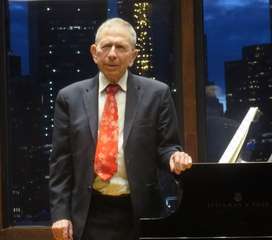|
Back
The Satisfaction of Vintage Wine New York
BargeMusic, Brooklyn
06/15/2018 -
Wolfgang Amadeus Mozart: Six Variations in F Major on “Salve tu, Domine”, K. 416e [398]
Franz Schubert: Impromptu in F Minor, D. 935, No. 1
Frédéric Chopin: Nocturne in F Major, Opus 55, No. 1
Johannes Brahms: Romanze in F Major, Opus 118, No. 5
Franz Liszt: Waldesrauschen, S. 145, No. 1 – Méphisto-Valse No. 1, S. 114
Béla Bartók: Etude, Opus 18, No. 2
Christian Sinding: Frühlingsrauschen, Opus 32, No. 3
Claude Debussy: Children’s Corner, L. 113
Jerome Lowenthal (Pianist)

J. Lowenthal at BargeMusic (© Samuel A. Dog)
Though a sucker for rum and vodka, I cannot resist a bottle of fine wine. Last night at BargeMusic, that wine was pure music, served under the appellation “Jerome Lowenthal”. And the sadly half-filled BargeMusic audience drank heavily from this extremely rare delicacy.
Mr. Lowenthal has a direct link to the brazen pianists of the 19th Century. That came after his study with that eccentric Texas dame, Olga Samarova-Stokowski, herself a student of Professor Alkan, whose father was Franz Liszt’s great rival.
At the age of 13, he debuted with Ormandy and the Philadelphia Orchestra. Since then, he’s been a soloist under Bernstein, Ozawa, Barenboim and Monteux. And though he has spent much time as a teacher, rather than endlessly plowing concert circuit, Mr. Lowenthal’s brilliance with Bartók, and Liszt, and his work with contemporaries like Ned Rorem are noted amongst fellow musicians. Still, he will be noted in the history books for having helped construct–and make the first recording of–Liszt’s “Third” Piano Concerto.
His most recent honor is Chair of the Juilliard Piano Department, not an emeritus position, but from his recital last night, a benefit to both school and students.
Never having heard him in concert, I was anxious hear Mr. Lowenthal at BargeMusic. But a glance at the program last week was initially disappointing. Nine works in a recital? An almost forgotten Romantic like Christian Sinding? A bit of Chopin and Schubert? I had no hesitation in going, but was looking for something...well...something perhaps meatier?
And oh, that had been a poor misreading of the works. Mr. Lowenthal’s performance we get to in a moment. But yes, the works were indeed challenging. Almost nobody plays the Bartók Etudes, their difficulties outweighing their effect in the recital hall. The Liszt Forest Murmurs is equally rare. And if Sinding’s “Rustle of Spring” seems old hat, the technique to make this ring is still audacious.
Yet from the first bars of Mozart’s rarely played “Salve tu, Domine” Variations, one heard the mastery of experience, of a conservative yet virtually holistic attitude to his instrument. Where others might use the Steinway pedal to make their mark, Mr. Lowenthal spared his feet, so the great piano runs were based on digital legatos. Nor did he ever overplay the retardos, pause for undue emotional effect.
The Mozart, based on a Paisiello opera aria, was played like a master teacher. The composer probably improvised the original, but Mr. Lowenthal never attempted the illusion of spontaneity. He played it with care, devotion and a flawless technique.
The following three Romantics (he made the first section all with keys of jaunty F Major and sad F Minor) had that same sense of dedication. No, Mr. Lowenthal is too young to have participated in the Horowitz-Cherkassky sense of coloristic exaggeration. Rather, he performed with the quiet majesty of experience and commitment to the composer.
Sectioning off the following three works was a regretful programmng error. Each one of these pieces transcends their brevity for massive piano-playing. They needed plaudits individually. And lumping them together, one lost the fierce demands. Granted, Liszt’s Forest Murmurs is hardly amongst his most familiar works, but Mr. Lowenthal knew never never to make the rolling tonal runs into showpieces. The composer was indeed painting a picture, and no excessive ear-catching fire was needed.
As for the Bartók Second Etude sandwiching this between two other composer was like crushing Beluga Caviar into an Oreo cookie. Nothing wrong with sweet melodies, but Bartók’s work was less showy, and far more difficult than it seemed. Mr. Lowenthal’s left hand arpeggios were always in command, as those harmonies hinted at Bartók’s transformation, those slight Magyar syncopations.
Again, Mr. Lowenthal played it with such quiet mastery that one unhappily drifted (without pause) into the familiar Christian Sinding rustle of spring. Familiar that may be, but what a powerhouse of strength it deserves. Iwould assume that a Trifonov or Hamelin would turn spring’s whispers into spring’s whirlwinds, but Mr. Lowenthal kept to the dazzlement of the notes themselves.
The longest work was Debusssy’s Children’s Corner, and for that, one might have longed for a bit more humor (that piano lid didn’t exactly bang in the first section, the Wagner Tristan notes were played literally, without the caustic irony). But this was the pianist’s choice.
Nobody can resist the fireworks of the First Mephisto-Waltz, and while Mr. Lowenthal couldn’t make it all hang together, he made up for that with an encore of Debussy’s Clair de lune. Like the rest of the concert, elegance was secondary to the ingenuous artlessness of his dedicated art.
Harry Rolnick
|